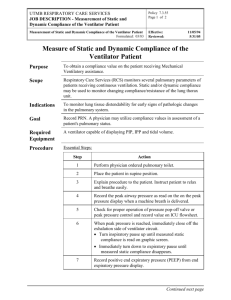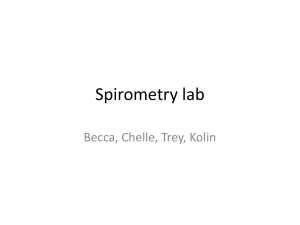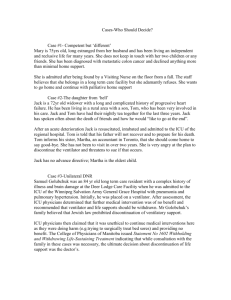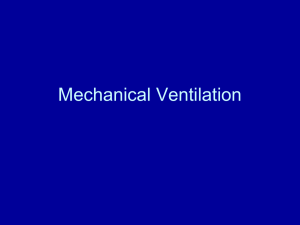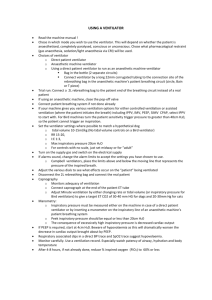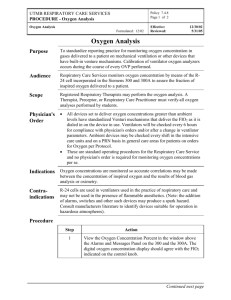MECHANICAL VENTILATION INDICATIONS
advertisement
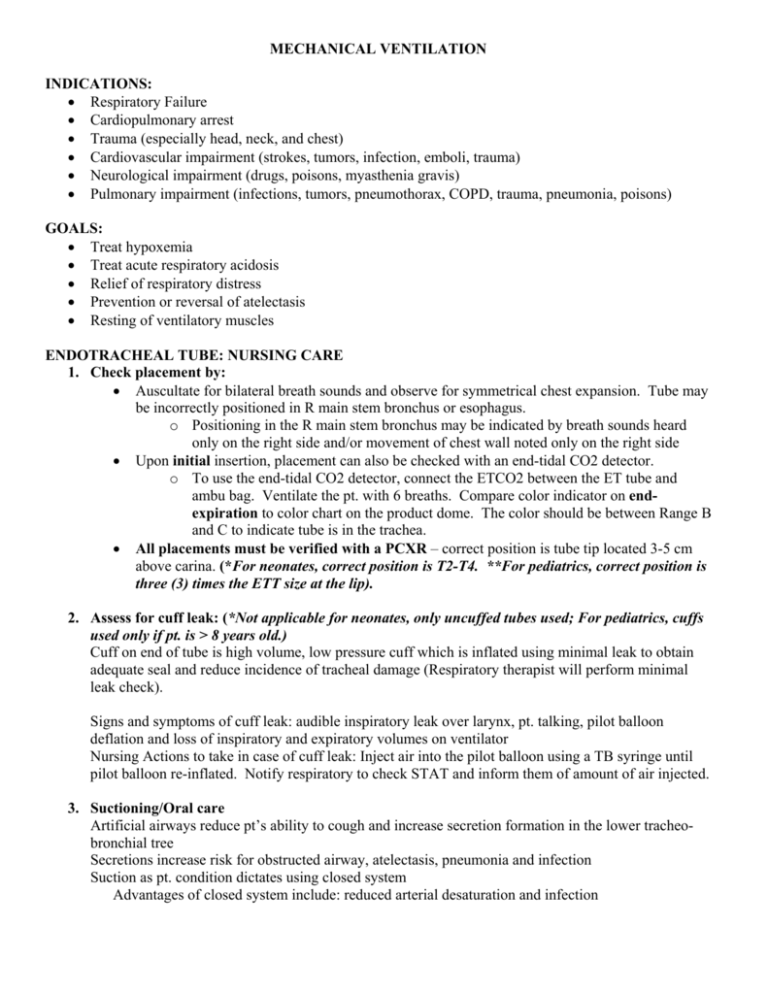
MECHANICAL VENTILATION INDICATIONS: Respiratory Failure Cardiopulmonary arrest Trauma (especially head, neck, and chest) Cardiovascular impairment (strokes, tumors, infection, emboli, trauma) Neurological impairment (drugs, poisons, myasthenia gravis) Pulmonary impairment (infections, tumors, pneumothorax, COPD, trauma, pneumonia, poisons) GOALS: Treat hypoxemia Treat acute respiratory acidosis Relief of respiratory distress Prevention or reversal of atelectasis Resting of ventilatory muscles ENDOTRACHEAL TUBE: NURSING CARE 1. Check placement by: Auscultate for bilateral breath sounds and observe for symmetrical chest expansion. Tube may be incorrectly positioned in R main stem bronchus or esophagus. o Positioning in the R main stem bronchus may be indicated by breath sounds heard only on the right side and/or movement of chest wall noted only on the right side Upon initial insertion, placement can also be checked with an end-tidal CO2 detector. o To use the end-tidal CO2 detector, connect the ETCO2 between the ET tube and ambu bag. Ventilate the pt. with 6 breaths. Compare color indicator on endexpiration to color chart on the product dome. The color should be between Range B and C to indicate tube is in the trachea. All placements must be verified with a PCXR – correct position is tube tip located 3-5 cm above carina. (*For neonates, correct position is T2-T4. **For pediatrics, correct position is three (3) times the ETT size at the lip). 2. Assess for cuff leak: (*Not applicable for neonates, only uncuffed tubes used; For pediatrics, cuffs used only if pt. is > 8 years old.) Cuff on end of tube is high volume, low pressure cuff which is inflated using minimal leak to obtain adequate seal and reduce incidence of tracheal damage (Respiratory therapist will perform minimal leak check). Signs and symptoms of cuff leak: audible inspiratory leak over larynx, pt. talking, pilot balloon deflation and loss of inspiratory and expiratory volumes on ventilator Nursing Actions to take in case of cuff leak: Inject air into the pilot balloon using a TB syringe until pilot balloon re-inflated. Notify respiratory to check STAT and inform them of amount of air injected. 3. Suctioning/Oral care Artificial airways reduce pt’s ability to cough and increase secretion formation in the lower tracheobronchial tree Secretions increase risk for obstructed airway, atelectasis, pneumonia and infection Suction as pt. condition dictates using closed system Advantages of closed system include: reduced arterial desaturation and infection Oral care (q 2-4 hr and prn) is important to decrease potential for infection such as ventilator associated pneumonia. Remember to suction oropharynx as well as down ET tube. *Suction depth for pediatrics is 1 cm below ETT, neonates ½ cm below ETT. Respiratory Therapist is responsible for making all vent changes, drawing ABG’s, extubating per MD order. At GMH, intubations may be performed by MD, anesthesiologist, CRNA, or trained resp. therapist. *In Neonatal ICU, intubations may be performed by MD, Neonatal Nurse Practitioner, Resp Therapist, and Transport Team members. **In Pediatric ICU, intubations may be performed by MD, Resp Therapist, and Transport Team members. 4. Elevate HOB 45 degrees to reduce potential for nosocomial pneumonias in mechanically ventilated pts. unless contraindicated by pt. condition (i.e. blood pressure, etc…) POSITIVE PRESSURE VENTILATORS: Pressure cycle: Allows air to flow into lungs until preset pressure has been reached. Once this pressure is reached, a valve closes and expiration begins. Volume of air delivered varies with changes in lung compliance and/or resistance. Volume cycled: Allows air to flow into lungs until a preset volume has been reached. Major advantage of this type is that a set tidal volume is delivered despite changes in compliance or resistance. Most commonly used – disadvantage is potential for high pressure. Time cycled: Allows air to flow into lungs until a preset time then expiration begins. VENTILATOR CONTROLS: Fraction of Inspired Oxygen (FiO2): Amount of oxygen delivered to the patient. Adjusted to maintain O2 sat of > 90%. Concern with oxygen toxicity with FiO2 > 60% required for 12-24 hours. *In Neonatal ICU and Pediatric ICU, O2 sats may differ based on patient disease process. Respiratory Rate: Number of breaths/min. ventilator is to deliver Tidal Volume: Amount of air delivered with each ventilator breath, usually set at 6-8 ml/kg. Sigh: Ventilator breath with greater volume than preset tidal volume, used to prevent atelectasis, however, not always used (Tidal volume may be enough to prevent atelectasis) Pressure limit: Limits highest pressure allowed by ventilator; Causes of high pressure alarm may include coughing, accumulation of secretions, kinked tubing, pneumothorax, decreased lung compliance Positive End Expiratory Pressure (PEEP): Pressure maintained in lungs at end of expiration used to improve oxygenation my opening collapsed alveoli, improving ventilation/perfusion, increasing oxygenation; can be used to reduce FiO2 Peak Inspiratory Pressure: Peak pressure registered on the airway pressure gauge during normal ventilation; PIP value used to set high and low pressure alarms; increased PIP may indicate decreased lung compliance or increased lung resistance Minute Volume or Minute Ventilation (Ve): Respiratory rate times the tidal volume RR x vt = Ve Normal minute volume for adults is 5-10 liters BASIC MODES OF VENTILATION MODE Assist Control or Volume Control *Not used in Neonatal ICU DEFINITION Vent delivers a preset tidal volume with a constant flow during a preset inspiratory time at a preset frequency Pt may initiate additional breaths but these breaths will be delivered at the preset tidal volume Pressure Control Vent delivers a breath with a decelerating flow during a preset inspiratory time, at a preset pressure and preset frequency Pt may initiate additional breaths but these breaths will be delivered at the preset pressure and inspiratory time No preset tidal volume so volumes may vary with changes in lung compliance i.e.: if the lungs become less compliant (stiffer), tidal volume will decrease vice versa if the lungs become more compliant (more elastic) the tidal volumes will increase INDICATIONS ADVANTAGES Guarantees the preset Total ventilatory rate and tidal volume support may be needed for a sedated or paralyzed pt. Helps decrease the work of breathing in pts. with unusually high minute ventilation as in the case of severe metabolic acidosis NOT used for weaning Used to limit peak Helps protect pressures and noncompliant improve lungs against oxygenation in pts. further injury with nonsuch as over compliant lungs distension or such as ARDS and prevent barotraumas by in Neonatal ICU controlling peak for RDS. pressures NOT used for Guarantees a weaning minimum rate Ability to manipulate inspiratory time while guaranteeing adequate flow DISADVANTAGES Risk of high peak pressures that may cause lung injury SAMPLE ORDER AC: 12 Vt: 600 cc PEEP 5 FiO2: 50% Pediatrics: Weight & Disease Process Dependent No guaranteed minimum volume May require increased sedation for patient comfort especially if using long inspiratory times PC 25 Frequency 16, I:E 1:1 PEEP 10 FiO2: 80% Pediatrics: Weight & Disease Process Dependent MODE Pressure Regulated Volume Control Synchronized Intermittent Mandatory Ventilation (SIMV) DEFINITION Control mode where ventilator delivers a preset tidal volume and frequency during a preset inspiratory time with decelerating flow. Ventilator will vary the inspiratory pressure control level to deliver the breath at the lowest possible pressure to guarantee the preset tidal volume and minute volume Ventilator monitors inspiratory pressures and changes breath by breath if needed until preset tidal volume is obtained Breaths are delivered the same as in volume control but the number of control breaths per minute is limited to the preset frequency Pt may take spontaneous breaths between the control breaths without assistance (or with augmentation if pressure support is used) INDICATIONS Combines the advantages of volume control and pressure control while eliminating the disadvantages Control mode so NOT used in weaning ADVANTAGES DISADVANTAGES Guaranteed preset Minor for a control mode tidal volume and frequency Limits peak airway pressures Better tolerated by patient with less sedation SAMPLE ORDER PRVC 14 Vt: 650 PEEP 5 FiO2: 40% SIMV 10 Vt 700 ml PEEP 5 FiO2: 30% Allows pt to breathe in a more natural manner and help maintain their PCO2 Allows for weaning by simply decreasing the frequency as the pt. improves. SIMV in conjunction with pressure support may be used with a full face mask (covers nose and mouth) for noninvasive ventilation – an option for short term support Guarantees preset tidal volume and frequency Allows pt to breathe spontaneously between controlled breaths May be used as a weaning mode Risk of lung injury due to high peak airway pressures Pediatrics: Weight & Disease Process Dependent Or SIMV 12 Vt 600 ml PS 5 PEEP 7.5 FiO2: 50% Pediatrics: Weight & Disease Process Dependent MODE Pressure Support DEFINITION Support mode where vent delivers breaths with preset pressure kept constant during inspiration with a decelerating flow Patient triggers all breaths Tidal volume achieved on pressure support is dependent on patient effort and lung compliance Volume Support *Not used in Neonatal ICU Support mode where ventilator delivers a preset tidal volume at a constant pressure with decelerating flow but pressure may vary from breath to breath depending on pts. need INDICATIONS If the respiratory drive is intact, may be used as the primary mode of ventilation Commonly used in conjunction with SIMV to augment the spontaneous breaths May be used in a non-invasive manner using a full face mask Most commonly used mode in weaning If pt is able to spontaneously breathe and achieve the preset tidal volume they may do so without any support If the pt effort falls short of the tidal volume, the ventilator will add support to reach the preset volume Breath to breath process to guarantee the set volume is at the lowest possible pressure level. ADVANTAGES Pt determines resp rate and inspiratory time Tolerated better than other modes since it most closely duplicates normal breathing DISADVANTAGES No preset tidal volume or frequency to guarantee ventilation SAMPLE ORDER PS 10 PEEP 5 FiO2: 50% OR PS : titrate for VT between 450-500ml PEEP 5 FiO2: 35% Pediatrics: Weight & Disease Process Dependent Pt determines resp rate and inspiratory time Provides backup mode and frequency in case of apnea: if the pt becomes apneic, the vent will automatically switch to PRVC Guarantees preset tidal volume and minute volume May reduce respiratory drive if tidal volume is set too high Requires thorough knowledge and understanding to optimize settings VS 550 ml, PEEP 5 O2: 40% Pediatrics: Weight & Disease Process Dependent MODE Continuous Positive Airway Pressure CPAP *In Neonatal ICU, infant flow used DEFINITION For spontaneous breathing pt., this mode of ventilation can be used for oxygenation problems. Allows pt to breathe spontaneously at a set positive pressure level No support provided by the ventilator to supplement the pt effort Increases oxygenation and helps maintain patency of airways Note that CPAP can be delivered to ventilated pts. and non-ventilated pts. * CPAP on a ventilated pt is referred to as “ET CPAP” CAUTION: For non-ventilated pts. receiving nasal or mask CPAP: Do not deliver po meds or give pt. fluids until the mask is completely removed! *Not applicable for NICU or PICU Do not occlude exhalation port INDICATIONS Pt MUST have intact respiratory drive and guaranteed tidal volume, minute volume or frequency May be delivered through an artificial airway (ET tube) or via a mask (nasal or full face) ADVANTAGES Allows for spontaneous respiration More comfortable for the pt. DISADVANTAGES No support or backup Possible complication of pneumothorax SAMPLE ORDER CPAP 10,FiO2 30% OXYGEN SATURATION In the pulmonary capillaries, the high oxygen tension provides an environment in which oxygen readily binds with hemoglobin. Each Hgb molecule can combine with 4 oxygen molecules- oxyhemoglobin. PaO2 vs. SaO2 PaO2: Measures partial pressure of oxygen dissolved in arterial blood Normal PaO2 = 80 – 100 mmHg (The PaO2 decreases in the elderly: for individuals 60–80 years old, the PaO2 ranges from 60–80 mmHg) SaO2: Refers to amount of oxygen bound to hemoglobin Amount of oxygen Hgb is carrying compared with amount of oxygen Hgb can carry Arterial oxygen saturation of Hgb Normal SaO2 = 90 – 100% Important because oxygen supplied to the tissues is carried by Hgb Pulse oximetry reflects the arterial oxygen saturation. Pulse oximetry uses light emitting diodes to measure pulsatile flow and light absorption of the hemoglobin. A sensor is placed on the finger, toe, earlobe, or forehead. Possible causes of inaccurate readings: Poor probe position Reduced cardiac output Low blood volume Hypothermia Carboxyhemoglobin Bright lights Decreased peripheral circulation CAUTION: Pulse oximetry does NOT distinguish between types of saturated Hgb. If the hemoglobin is saturated with carbon monoxide, it will read the same as if it were saturated with oxygen. Use with caution in carbon monoxide poisoning and heavy smokers. OXYHEMOGLOBIN DISSOCIATION CURVE The oxyhemoglobin dissociation curve shows the relationship between SaO2 and PaO2 and provides the basis for pulse oximetry. Note that the initial part of the curve is very steep and then flattens at the top. The flattened portion of the curve shows that large changes in PaO2 results in only small changes in SaO2. The critical part of the curve is the point when the PaO2 falls below 60 mmHg. At this point, the curve drops sharply indicating that, now, small changes in PaO2 are reflected in large decreases in SaO2. Oxygen delivery to the tissues is compromised. Remember the 90/60 rule! 90 Shift to left PaCO2 Temperature SaO2 (%) 70 pH Shift to right PaCO2 Temperature 50 pH Normal 30 10 10 30 50 70 90 PaO2 (mmHg) 110 130 VENTILATOR ALARM TROUBLESHOOTING: High pressure alarm: a. Pt needs suctioning, pt is coughing b. Heat Moisture Exchanger (HME)/ “Artificial” nose: increased resistance due to excessive moisture or secretions in HME c. Obstructed, kinked ET tube: pt biting tube d. Crimped ventilator circuit: pt or object lying on circuit *In Neonatal ICU and Pediatric ICU, high pressure alarm set 5-10 above PIP Low pressure alarm a. Disconnection: check to see if pt disconnected from vent circuit and circuit disconnected from vent b. Air leak: leak in circuit, leak in ET tube (check for possible extubation, cuff above vocal cords) Low volume/apnea a. Disconnection/leak: check to insure pt connection to circuit and circuit to vent intact b. Apnea: pt may need to be placed on mode to ensure minimum rate or rate needs to be increased *In Neonatal ICU and Pediatric ICU, check for disconnection, water in tube, air leak or need for suctioning COMPLICATIONS OF MECHANICAL VENTILATION: Aspiration Tracheal stenosis, laryngeal edema Infection Barotrauma Decreased cardiac output, especially with PEEP Fluid retention Immobility Stress ulcer, paralytic ileus Inadequate nutrition Medications for mechanically ventilated patients:* Used to minimize discomfort, reduce anxiety, facilitate mechanical ventilation and improve oxygenation Analgesics: pain relief and some side effect of sedation – morphine Sedatives: Benzodiazepines – Ativan, Versed Propofol (Diprivan): short acting anesthetic agent, continuous infusion, onset of less than 1 minute Begin at 5 mcg/kg/min, increase by 5-10 mcg/kg/min in 5-10 minute intervals Maintenance rates: 5 – 50 mcg/kg/min Premixed in glass bottle, 10 mg/ml (100 cc bottle), filtered tubing IV tubing and any unused portion should be discarded every 12 hrs. Don’t forget to treat pain even though pt. may be sedated. Treating pain may reduce amount of sedation required. *Refer to pain/sedation management protocol for mechanical ventilated pts. (attached) **In Neonatal ICU, refer to NICU pain management protocol ***In Pediatric ICU, pain management is determined by clinical situation, patient assessment, and decision of the Pediatric Intensivists: refer to MD specific orders. Neuromuscular Blocking Agents: Pavulon, Tracrium, Norcuron – Induce paralysis, have NO sedative or analgesic effect-pt will require sedative and analgesic agents Use peripheral nerve stimulation with Train of Four to assess level of paralysis and titration of ordered agent WEANING/EXTUBATION: Short term vs. long term: Pts. on vents for short periods of time are generally easier to wean. Usually weaning consists of decreasing rate, assessing respiratory mechanics and vital signs. * In Neonatal ICU, refer to NICU weaning protocol. **In Pediatric ICU, determined by Pediatric Intensivists. Pts. on vents for long periods of time may be weaned using trials of decreased vent settings and/or T piece trials of increasing frequency and time with periods of rest back on the ventilator. T piece trials: Pt. remains intubated but connected to oxygen source via T-piece. Assess pt. resp effort, O2 sat, HR and BP. Duration of trial will vary from pt. to pt. *Not applicable in Neonatal ICU and Pediatric ICU Extubation can be performed by resp. therapist upon order of physician. Have equipment/supplies ready for reintubation emergently if needed. Pt. is suctioned before removal, tape loosened and cuff deflated. ET tube removed as patient coughs. Immediately assess pt. for stridor, dyspnea and decreased O2 sat. Pt. is placed on oxygen mask or cannula post extubation. Observe and document resp. rate/effort and O2 sat. Self extubation: Assess pts need for restraints while intubated to protect airway. In case of self extubation, immediately assess pt. resp status. Assess for stridor, Auscultate lung sounds Use ambu bag with O2 @ 10-15 l/min to maintain airway and ventilate pt as needed. *Use only 5 l/min with ambu bags in Neonatal ICU If pt in resp distress; prepare for emergency re-intubation. If pt. spontaneously breathing with little or no resp distress, place on oxygen mask or nasal cannula with assistance of resp. therapist. Obtain ABG’s, monitor O2 sat. Notify MD and respiratory STAT. Developed by: Wanda Perry, M.Ed., RRT, Clinical Manager Respiratory Care Janice Lanham, RN, MSN, Clinical Nurse Specialist, ICU/GMH Lavunda Martin, RN, Clinical Nurse Educatory, ICU/GMH Sheryl Sheriff, RN, MSN, Clinical Nurse Specialist, CCU/GMH Jan Smith, RN, BSN, Clinical Nurse Educator, Perioperative Services, GMH References: Lynn-McHale, Debra J. and Carlson, Karen, ed. (2001) AACN Procedure Manual for Critical Care (4th ed.). Philadelphia: W.B.Saunders Company. Hudak, Carolyn N., Gallo, Barbara M. and Morton, Patricia Gonce. (1998) Critical Care Nursing, A Holistic Approach (7th ed.) Philadelphia: Lippincott COMPETENCY ASSESSMENT: MANAGEMENT OF MECHANICALLY VENTILATTED PATIENT Name:_______________________________________ Date: ____________ Score:_____________ ___1. All of the following are methods for checking proper placement of the ET tube EXCEPT: a. Ensuring lungs sounds are auscultated bilaterally b. Obtain PCXR c. 1 cm marking of ET tube at mouth or nare d. Use of end-tidal CO2 detector ___2. You suspect that Mrs. Smith may have a cuff leak. You would assess for the following signs and symptoms: a. Pt able to speak b. Pilot balloon deflated c. Inspiratory and expiratory volume alarm settings “going off” on vent d. All of the above ___3. True or False: If pt is talking “around the tube” the nurse should inject air into the pilot balloon using a TB syringe until pilot balloon re-inflated and notify respiratory to check STAT. ___4. Mr. Breathe Easy is on the ventilator and you note that the high pressure alarm is “going off”. You should: a. Check to see if pt. needs suctioning or is coughing b. Check ventilator circuit for “crimps”/obstructed or kinked ET tube c. Notify respiratory to reset the high pressure alarm because it is going off too frequently d. a and b e. a and c ___5. What should always be kept at the bedside of a pt on a mechanical ventilator? a. Nasal cannula for supplementary O2 b. Ambu bag c. Restraints ___6. The ventilator low pressure alarm is going off on Mrs. Cough. You check her and note her O2 sat has rapidly dropped and she is in acute respiratory distress and is agitated. You cannot determine any problem with the vent to correct the alarms. You should: a. Disconnect her from the vent and ventilate using the ambu bag with O2 @ 10-15 l/min.. Notify respiratory STAT. b. Notify respiratory STAT and wait for them to troubleshoot the alarms before ever disconnecting a pt. from the vent. c. Administer pain and or sedation medications as ordered. ___7. You respond to vent alarms in Mr. Jones room. You notice that in his restrained left hand he is holding his ET tube. In all cases of self-extubation, you should: a. Notify the MD and anesthesia stat and immediately prepare for re-intubation. b. Assess the pt’s respiratory effort and O2 sat. Support respirations/oxygenation with ambu bag or supplemental O2 via mask/cannula as needed. Notify MD and respiratory STAT. c. Call a Code. ___8. Two possible complications associated with PEEP are: a. Decreased cardiac output b. Cerebral aneurysm c. Barotrauma d. b and c e. a and c ___9. The O2 sat provides information about: a. Relationship between PaO2 and percentage of Hgb saturation b. The body’s oxygen demand c. Partial pressure of oxygen dissolved in arterial blood ___10. The oxyhemoglobin dissociation curve shows the relationship between SaO2 and PaO2. What is the 90/60 rule? a. A mathematical formula used for calculating the oxygenation status of the pt. which factors in the body’s supply and the body’s demand for oxygen. b. A point on the curve which depicts that when the PaO2 reaches 60 the O2sat may still be 90. However at this point, small decreases in PaO2 are associated with large decreases in SaO2. c. A SaO2 of 90 always indicates a PaO2 of 60. For pediatric areas only: ___11. ET cuffed tubes are to be used in what population? a. All ages b. Children less than 8 years old c. Children more than 8 years old ___12. The correct position of the ET tube for pediatrics is: a. T2 – T4 b. 1 cm above the carina c. 3 times the ETT size at the lip

